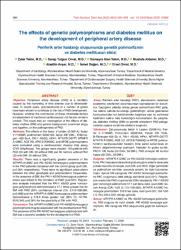| dc.contributor.author | Yalım, Zafer | |
| dc.contributor.author | Tutgun Onrat, Serap | |
| dc.contributor.author | Alan Yalım, Sümeyra | |
| dc.contributor.author | Aldemir, Mustafa | |
| dc.contributor.author | Avşar, Alaettin | |
| dc.contributor.author | Doğan, İsmet | |
| dc.contributor.author | Onrat, Ersel | |
| dc.date.accessioned | 2021-05-05T22:16:54Z | |
| dc.date.available | 2021-05-05T22:16:54Z | |
| dc.date.issued | 2020 | |
| dc.identifier.issn | 1016-5169 | |
| dc.identifier.issn | 1308-4488 | |
| dc.identifier.uri | https://doi.org/10.5543/tkda.2020.15686 | |
| dc.identifier.uri | https://app.trdizin.gov.tr/makale/TXpZNE9EUXdNQT09 | |
| dc.identifier.uri | https://hdl.handle.net/20.500.12933/430 | |
| dc.description.abstract | Objective: Peripheral artery disease (PAD) is a condition caused by the narrowing of limb arteries due to atherosclerosis. In recent years, polymorphisms in a number of genes have been shown to contribute to the risk of PAD development. However, whether the contribution of these inheritable factors is independent of traditional cardiovascular risk factors remains unclear. This study was an investigation of the effects of diabetes mellitus (DM) and genetic background, examined singly and together, on the pathogenesis of PAD. Methods: The effects of the factor V Leiden (G1691A), factor V H1299R, prothrombin G20210A, factor XIII V34L, B-firinogen -455 G>A, PAI-1 4G/5G, HPA1, MTHFR C677T, MTHFR A1298C, ACE I/D, APO B R3500Q, and APOE polymorphisms were evaluated using a cardiovascular disease strip assay (CVD StripAssay). Two groups were created: 100 patients with PAD (50 with DM, 50 without DM) and 60 controls without PAD (30 with DM, 30 without DM). Results: There was a signifiantly greater presence of the MTHFR A1298C and PAI 4G/5G homozygous polymorphisms in the PAD patients compared with the control group (p=0.035, p=0.004, respectively). There were no signifiant associations between the other genotypes and polymorphism frequencies. In the presence of DM, the PAI-1 4G/5G homozygous polymorphism was linked to the formation of PAD (p=0.021). Regression analysis indicated that the PAI-1 4G/5G gene homozygous polymorphism demonstrated a 17.1 times greater risk for DM with PAD [95% confience interval (CI): 2.113-138.660; p=0.008] and the MTHFR A1298C homozygous polymorphism demonstrated a 316.6 times greater risk (95% CI: 10.763- 9315.342; p<0.001) for the possibility of DM with PAD. Conclusion: The MTHFR A1298C and PAI 4G/5G homozygous polymorphisms may be associated with the development of PAD. The presence of the PAI 4G/5G homozygous polymorphism with DM was a powerful predictor for the development of PAD | en_US |
| dc.description.abstract | Amaç: Periferik arter hastalığı (PAD), ateroskleroz nedeniyle ekstremite arterlerinin daralmasından kaynaklanan bir durumdur. Geçtiğimiz yıllarda, birkaç gende polimorfimin PAD geliş- me riskine katkıda bulunduğu gösterilmiştir, ancak geleneksel kardiyovasküler risk faktörlerinden bağımsız olan bu kalıtımsal faktörlerin katkısı hala belirsizliğini korumaktadır. Bu çalışmada, diabetes mellitus (DM) ve genetik arkaplanın PAD patogenezinde sadece ve birlikte etkilerini araştırdık. Yöntemler: Çalışmamızda faktör V Leiden (G1691A), Faktör V H1299R, Protrombin G20210A, Faktör XIII V34L, B-Fibrinojen-455 G> A, PAI-1 4G/5G, HPA1, MTHFR C677T, MTHFR A1298C, ACE I/D, APO B R3500Q ve APOE polimorfiminin kardiyovasküler hastalık Strip panel kullanılarak etkilerini değerlendirmeyi planladık. Hastalar iki gruba ayrıldı: PAD’lı 100 hasta (50 DM+, 50 DM-), PAD olmayan 60 kontrol hasta (30 DM+, 30 DM-). Bulgular: MTHFR A1298C ve PAI 4G/5G homozigot polimorfimi, PAD hastalarında kontrol grubuna göre anlamlı derecede yüksek bulundu (sırasıyla, p=0.035, p=0.004). Diğer genotipler ve polimorfim sıklıkları arasında anlamlı bir ilişki bulunamamıştır. Ayrıca DM varlığında PAI 4G/5G homozigot polimorfimi PAD oluşumunu etkili olduğu belirlendi (p=0.021). Regresyon analizinde PAD oluşumunda DM+ hastalarda PAI-1 4G/5G gen homozigot polimorfimi 17.1 kat daha riskli, (p=0.008) Gü- ven Aralığı (GA) %95 (2.113–138.660), MTHFR A1298C homozigos polimorfimi 316.6 kat daha riskli (p<0.001) GA %95 (10.763–9315.342) olduğu görüldü. Sonuç: MTHFR A1298C ve PAI 4G/5G homozigoz polimorfimi, PAD oluşumu ile ilişkili olabilir. PAİ 4G/5G homozigot polimorfimi, DM varlığında PAD oluşumunda güçlü bir belirleyicidir. | en_US |
| dc.language.iso | eng | en_US |
| dc.rights | info:eu-repo/semantics/openAccess | en_US |
| dc.subject | [No Keywords] | en_US |
| dc.title | The effects of genetic polymorphisms and diabetes mellitus on the development of peripheral artery disease | en_US |
| dc.title.alternative | Periferik arter hastalığı oluşumunda genetik polimorfimin ve diabetes mellitusun etkisi | en_US |
| dc.type | article | en_US |
| dc.department | AFSÜ, Tıp Fakültesi, Dahili Tıp Bilimleri Bölümü, Kardiyoloji Ana Bilim Dalı | en_US |
| dc.contributor.institutionauthor | Yalım, Zafer | |
| dc.contributor.institutionauthor | Tutgun Onrat, Serap | |
| dc.contributor.institutionauthor | Alan Yalım, Sümeyra | |
| dc.contributor.institutionauthor | Avşar, Alaettin | |
| dc.contributor.institutionauthor | Doğan, İsmet | |
| dc.contributor.institutionauthor | Onrat, Ersel | |
| dc.identifier.doi | 10.5543/tkda.2020.15686 | |
| dc.identifier.volume | 48 | en_US |
| dc.identifier.issue | 5 | en_US |
| dc.identifier.startpage | 484 | en_US |
| dc.identifier.endpage | 493 | en_US |
| dc.relation.journal | Türk Kardiyoloji Derneği Arşivi | en_US |
| dc.relation.publicationcategory | Makale - Uluslararası Hakemli Dergi - Kurum Öğretim Elemanı | en_US |
















